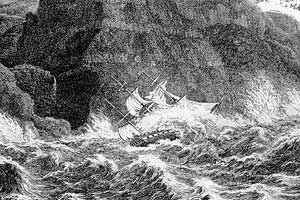 |
| Home | Wreck Locations | Wrecks Gallery | Lifeboat Locations | Atherfield Gallery | Brighstone Gallery | Brook Gallery |
| Coxswains | Awards & Medals | Atherfield Journal | Brighstone Journal | Brook Journal | Headstones | Links | Info Wanted |
 | Clarendon |
| Came to grief: 11th October 1836 at/near Blackgang | |
| Captain Samuel Walker | |
| Cargo: sugar, molasses & rum | |
| Crew of 17 | |
| Carrying 11 passengers | |
Probably the best known wreck is that of The Clarendon. She left St. Kitts (W. Indies) on 27th Aug 1836 with a cargo of sugar, molasses & rum, under Captain Samuel Walker, carrying 11 passengers and 17 crew. At 6am on the morning of 11th October, in a howling gale and huge seas, The Clarendon hit the beach broadside, rolling over on her side. She broke up in less than ten minutes. Only 3 crew survived. A family of 6 perished - Lt. Shore (14th Regiment), his wife & 4 daughters, aged between 9 months and 18 years. Amongst the others drowned was a Miss Gourlay, daughter of Captain Gourlay R.N. Her body was carried out to sea and cast ashore at Southsea, opposite her father's house. A local fisherman, John Wheeler, was largely responsible for the rescue of three of the crew. With a few men on the beach end of a rope and the other tied around his waist, he ran into the surf and shouted for those on board to jump. Three jumped and he managed to drag them to the shore, but the Clarendon, broadside to the beach, only survived three seas, and was broken up by the fourth. All remaining on board were either drowned or killed by the timbers in the pounding surf. Eighteen of the victims are interred in Chale Churchyard. By remarkable coincidence, John Thomson, one of the three men saved by Wheeler, had served with him on the Falcon, Lord Yarborough's yacht. Four years before, Thomson had saved Wheeler’s life. So great was this disaster that the building of a lighthouse began in 1837, at St Catherine's Point. It was completed and first used on March 25th 1840. | |
Fatalities: 25 | |
Bibliography: Back of the Wight - Fred Mew Shipwrecks of the Wight - J.C.Medland Shipwrecks of The Isle of Wight - Ken Phillips The Lifeboats of Brighstone Bay - Christopher J. Willis and Edward H. Roberts |